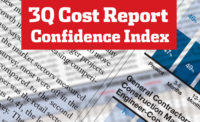Like death and taxes, a market downturn is inevitable. And for the industry, it is just a matter of when. While the current market continues to grow, industry execs increasingly are checking for signs that the market may be slowing.
The contrast between current conditions and future market expectations can be seen in the latest results of the ENR Construction Industry Confidence Index survey. The CICI fell one point to 58 in the second quarter of 2019, from 59 in the first quarter. Of the 238 executives from large construction and design firms responding to the survey, many believe the market is beginning to soften and may begin declining next year.
This sense of an impending downturn doesn’t mean that the current construction market is in trouble. Only 5% of survey respondents believe it has started to decline now, and only 8% say a decline could start in three to six months. On the other hand, 30% speculate the market will start to shrink in the next 12 to 18 months, compared to only 11% who believe it will still be growing in that timeframe.
The CICI measures executive sentiment about the current market, where it will be in the next three to six months and over a 12- to 18-month period. A rating above 50 shows a growing market. The index is based on responses to surveys sent between May 16 and June 24 to 6,000 U.S. companies on ENR’s lists of leading general contractors, subcontractors and design firms.
|
Related Link |
CFMA: CFOs Remain Wary
The industry’s concerns about next year can be seen in the soon-to-be-released results of the latest Confindex survey from the Construction Financial Management Association, Princeton, N.J., which show that CFOs are worried about the market climate in 2020.
Each quarter, CFMA polls 200 CFOs from general and civil contractors and subcontractors. The CFMA Confindex is based on four separate financial and market components, each rated on a scale of 1 to 200. A rating of 100 indicates a stable market; higher ratings indicate market growth.
“The Confindex rose from 109 in the previous quarter to 111 in the current quarter,” says Stuart Binstock, CFMA’s CEO. He notes the contrast between the current market and CFMA members’ concerns over next year.
The Confindex components associated with the current market reflected a positive attitude. The “financial conditions” component rose three points to 118, while the “current conditions” component fell four points 117, still a sign of a healthy market.
On the other hand, the forward-looking “general business conditions” component remained stable at 102, while the “year-ahead outlook” rose eight points, to 103. Both of these show that CFOs believe that 2020 will be a flat market.
Public vs. Private
The ENR CICI index also can be applied to each of the 15 individual markets in the survey. These individual market ratings show the strength of the public sector construction scene. This quarter, transportation had the highest confidence rating, at 72. The water and wastewater market dropped six points, but still registered a healthy 61 rating.
Much of this confidence in the public sector market can be attributed to state and local spending. “The strong economy has resulted in higher state and local tax revenue, which is a major driver in the hot public sector market,” says Anirban Basu, CEO of economic consultant Sage Policy Group, Baltimore, and a CFMA adviser. He notes that this strength comes despite a failure to pass major federal infrastructure spending bills.
On the other hand, some of the private buildings sectors are beginning to show signs of a strain. The retail sector continues to be the only market surveyed that shows a current decline, with a 37 rating. The entertainment sector had a 50 rating, a flat market; the multi-unit residential market, once the hottest market, has fallen to a 52 rating.
Many industry executives believe that increased construction costs, spurred by higher materials prices and labor costs, have many developers and financial institutions rethinking their plans.
“There is an increasing pessimism among our CFO members about 2020 and 2021,” says Basu. He says rising construction costs are making it more difficult for owners and banks to make their pro forma numbers. “Plus, there is some uncertainty about the impact of the 2020 presidential election,” he says.
Labor shortages are on the minds of many in the industry. In this quarter, ENR asked survey respondents whether staff shortages have gotten better or worse in the past year, and 52.4% said shortages have gotten worse, including 5.1% that said they have gotten much worse. Only 10.1% said that shortages have eased in the past year.
Further, 66.8% of respondents say they have implemented programs to enhance recruitment and retention of staff. The most common program is to develop or enhance recruitment advertising and outreach, including using social media.
Many firms also are upping salaries and are adding or increasing the level of benefits. Among the new benefits mentioned were 401(k) plans, personal time-off programs, half-day Fridays, enhanced insurance coverage, travel and incentive bonuses, training and career path programs, and even free lunches.



